Multiple Choice
December 18, 2010 at 7:26 pm · Filed under Content / Architecture, Copy / Writing, Drawing / Illustration, Naming / Words, Photography / Film, Print / Editorial
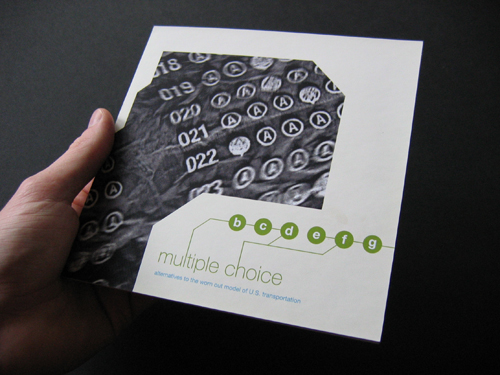
Multiple Choice, Alternatives to the Worn Out Model of U.S. Transportation booklet; front cover; 4.5 x 4.5in.; 28ppg. / 2003
Teen angst is a powerful force not often harnessed for forward progress. At the same time, many of today’s most overwhelming transportation problems are fueled by inertia. There is one predominantly accepted model that most people of driving age accept as given and therefore perpetuate. If there’s one thing kids hate, it’s being told that they have to do something a certain way. Multiple Choice plays between both of these phenomena.
This book, one of a few projects undertaken for the Publications course in the UW Visual Communication Design program, was designed as a thought leadership piece that might be put out by a major car maker to mark an openness to new ideas, sparking productive discourse on the future of transportation…
Content is related to the youth in abstracted vernacular of the age-old standardized test. But the point that’s being driven throughout is that, unlike such tests, these issues have more than one right answer, and the answer most commonly accepted is not necessarily right at all. This isn’t a test after all; it’s a challenge.
At the beginning of each section, two questions are posed: concerning the current situation: Why?, with the prevailing, claustrophobic choice as the only choice, and, considering several alternatives in an open context, Why not?.
The book is divided into four sections. The first, Dinosaur Technology, focuses on fuels, asking Why only fossil fuels? (as illustrated by oil derrick bubbles) and Why not hydrogen/fuel-cell, electric, solar, biodiesel or even wind-power?
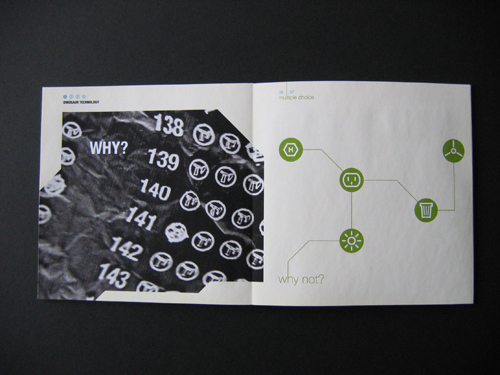
Multiple Choice, Alternatives to the Worn Out Model of U.S. Transportation booklet; front cover; 4.5 x 4.5in.; 28ppg. / 2003
The sections then cite a quote about the detrimental effects of the current “right answer”—here an excerpt from The Nation decrying the inefficiency and inscrutable political backing of fossil fuel—while sharing brief descriptions of the alternatives.
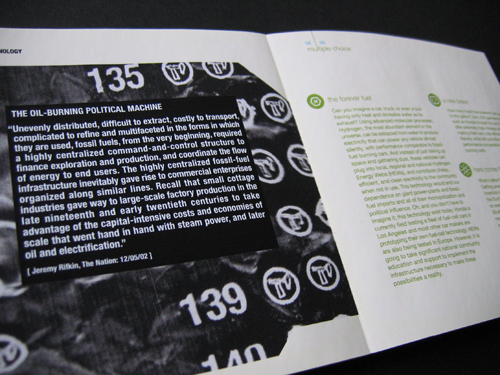
Multiple Choice, Alternatives to the Worn Out Model of U.S. Transportation booklet; Dinosaur Technology chapter head; 9 x 4.5in. (spread); 28ppg. / 2003
In the spirit of test-taking, each description begins with a simple question. The writing is kept brief and light, but informative. At the end of each section, simple information graphics compare relevant statistics between all of the choices, such as mile per dollar, contrasted with contrary government subsidy.
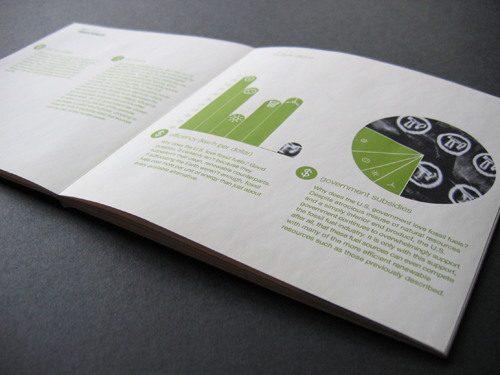
Multiple Choice, Alternatives to the Worn Out Model of U.S. Transportation booklet; Dinosaur Technology chapter head; 9 x 4.5in. (spread); 28ppg. / 2003
The next section, Vehicular Suicide, focuses on efficient uses of vehicles, asking Why single-occupancy in large vehicles like SUVs, and Why not carpooling, public transportation, motorcycling, cycling, or even the curious Segway?
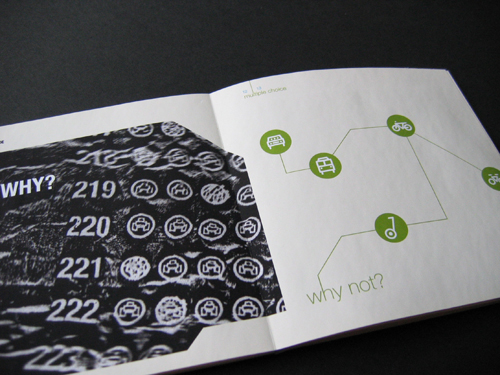
Multiple Choice, Alternatives to the Worn Out Model of U.S. Transportation booklet; Vehicular Suicide chapter head; 9 x 4.5in. (spread); 28ppg. / 2003
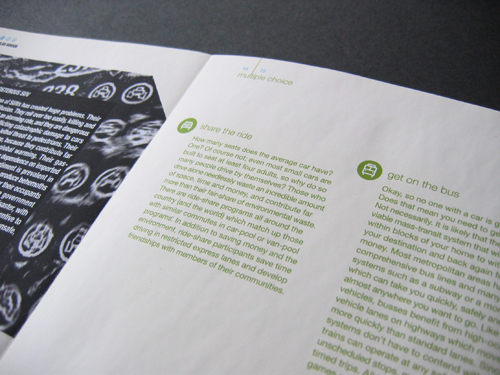
Multiple Choice, Alternatives to the Worn Out Model of U.S. Transportation booklet; Vehicular Suicide alternative descriptions; 9 x 4.5in. (spread); 28ppg. / 2003
Information graphics compare emissions per person per day with cost per day.
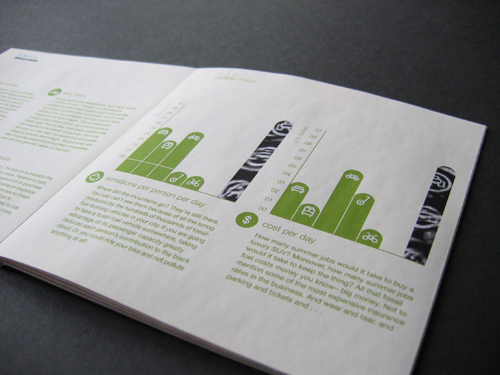
Multiple Choice, Alternatives to the Worn Out Model of U.S. Transportation booklet; Vehicular Suicide information graphics; 9 x 4.5in. (spread); 28ppg. / 2003
The third section, Going Nowhere Fast, focuses on how those vehicles get from point-A to point-B, and asks Why just the static highway tangles currently in place? and Why not some more efficient, safe and/or easy alternatives, such as splitting highway systems into levels for different uses, automatically-linked vehicle caravans, hyper-efficient magnetic track systems or even more futuristic bubble technology?
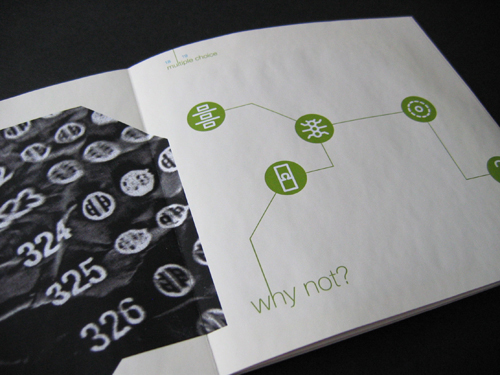
Multiple Choice, Alternatives to the Worn Out Model of U.S. Transportation booklet; Going Nowhere Fast chapter head; 9 x 4.5in. (spread); 28ppg. / 2003
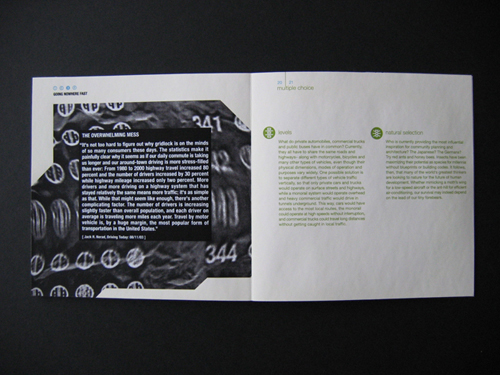
Multiple Choice, Alternatives to the Worn Out Model of U.S. Transportation booklet; Going Nowhere Fast chapter head; 9 x 4.5in. (spread); 28ppg. / 2003
This section is summed up with comparisons of time wasted in traffic in different U.S. cities currently, ranging anywhere from about 50 to 80 hours per year.
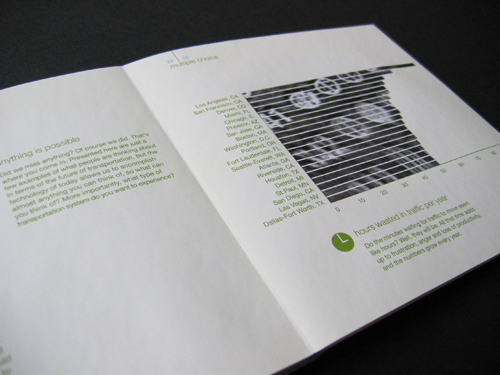
Multiple Choice, Alternatives to the Worn Out Model of U.S. Transportation booklet; Going Nowhere Fast chapter head; 9 x 4.5in. (spread); 28ppg. / 2003
Lastly, What Now? asks readers to contemplate what to do with all these choices and offers an interactive CD-ROM with tunes for the next commute, as well as information on how the youths’ can use their informed chutzpah to challenge friends, family, and political representatives whose standstill status quo is so rarely challenged otherwise.
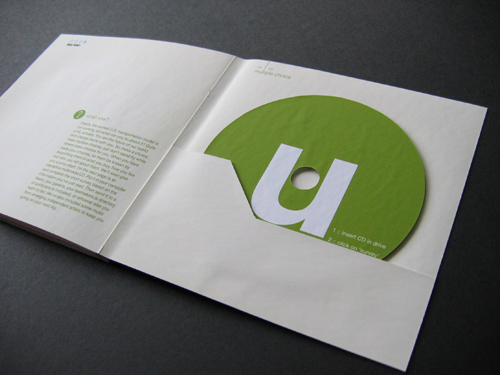
Multiple Choice, Alternatives to the Worn Out Model of U.S. Transportation booklet; What Now? information/CD; 9 x 4.5in. (spread); 28ppg. / 2003
